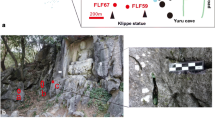Abstract
Biochemical weathering mechanisms carried out by Penicillium frequentans and Cladosporium cladosporoides on unaltered sandstone, granite and limestone were studied using FTIR, X-ray diffraction, atomic absorption and flame photometry. Strains belonging to both fungal species, isolated from the façades of two Spanish Cathedrals, were used.
Large amounts of oxalic, citric and gluconic acids were produced by P. frequentans in broth cultures. These metabolites caused extensive deterioration of clay silicates, micas and feldspars from both sandstone and granite and also of calcite and dolomite from limestone, as a result of high cation release and organic salts formation such as calcium, magnesium and ferric oxalates and calcium citrates. Comparatively, the biodegradative effect brought about by C. cladosporoides was much less than that caused by P. frequentans. Neither organic acids nor organic salts were formed by C. cladosporiodes samples.
It is concluded that filamentous fungi are able to cause an extensive weathering of stone, due principally to organic acid excretion, although other metabolites participate to a lesser extent in these deteriorative processes. Ecological adaptative mechanisms, such micronutrients uptake and trivalent cations chelation (Fe3+ and Al3+) are derived from fungal growth on stone monuments.
Similar content being viewed by others
References
Ascaso C, Galvan J & Rodriguez-Pascual C (1982) The weathering of calcareus rocks by lichens. Pedobiologia 24: 219–229
Cancer EN & Boke H (1989) Occurrence of calcium oxalates on marble monuments in Anatolia. In: Proc. Int. Symp. The Oxalate Films: Origin and Significance in the Conservation of Works of Art (pp 299–307). Centro C.N.R. Gino Bozza, Milan
Chiari G, Samp S & Torraca G (1989) Formazione di ossalati di calcio su superfici marmoree da parte di funghi. In: Proc. Int. Symp. The Oxalate Films: Origin and Significance in the Conservation of Works of Art (pp 85–90). Centro C.N.R. Gino Bozza, Milan
Eckhardt FEW (1979) Über die Einwirkungheterotropher Mikroorganismen auf die Zersetzung silikalischer Minerale. Z. Pfland. Bodenzunde 142: 434–445
Eckhardt FEW (1980) Microbial degradation of silicates. Release of cations from aluminosilicate minerals by yeast and filamentous fungi. In: Oxley TA, Allsopp D & Becker G (Eds) Biodeterioration (pp 107–116). Pitman Publ., London
Eggins HOW & Allsopp D (1975) Biodeterioration and Biodegradation by Fungi. In: Smith JE & Berry DR (Eds) The Filamentous Fungi. Industrial Mycology vol. 1 (pp 301–319). E. Arnold, London
Ehrlich HL (1990) Geomicrobiology. Marcel Dekker Inc., New York
Gorlenko M (1983) Some biological aspects of biodeterioration. In: Oxley TA & Barry S (Eds) Biodeterioration 5 (pp 578–581). John Wiley & Sons Ltd., Sussex
Hall R (1981) Physiology of Conidial Fungi. In: Cole GT & Kendrick B (Eds) Biology of Conidial Fungi vol 2 (pp 417–455). Academic Press, New York
Huang WH & Keller WD (1972) Organic acids as agents of chemical weathering of silicate minerals. Nature 239: 149–151
Hueck van derPlas E (1968) The microbiological deterioration of porous building materials. Int. Biodetn. Bull. 4: 11–28
Joints Committee on Powder Diffraction Standards (JCPDS) (1989) International Centre for Diffraction Data. Swarthmore, PA 19081-2389-USA
Jones B & Pemberton G (1987) Experimental of spiky calcite through organically mediated dissolution. J. Sediment Petrol. 57: 687–694
Krumbein WE (1988) Microbial interactions with mineral materials. In: Houghton DR, Smith RN & Heggins HOW (Eds) Biodeterioration 7 (pp 78–100). Elsevier, London
Kurozckin J, Bode K, Petersen K & Krumbein WE (1988) Some physiological characteristics of fungi isolated from sandstone. In: Proc. VIth Int. Congress on Deterioration and Conservation of Stone (pp 21–25). Nicholas Copernicus University, Torum
Lazzarini L & Salvadori O (1989) A reassessment of the formation of the patina called “scialbatura”. Studies in Conservation 32: 114–121
Manley EP & Evans LJ (1986) Dissolution of feldspars by low-molecular-weight aliphatic and aromatic acids. Soil Sci. 141: 106–112
Marel van der HW & Beutelspacher H (1976) Atlas of Infrarred Spectroscopy of Clay Minerals and their Admixtures. Elsevier, Amsterdam
Razzell WE & Trussell PC (1963) Isolation and properties of an iron oxidizing Thiobacillus. J. Bacteriol. 85: 595–603
Robert M & Razzaghe-Karimi MH (1975) Mose et évidence de deux types d'evolution minéralogique des micas trioctaédriques en présence d'acides organiques hydrosolubles. C.R. Acad. Sci. Paris 280: 2175–2178
Rossi G (1978) Potassium recovery through leucite bioleaching possibilities and limitations. In: Murr LE, Torma AE & Brierley JA (Eds) Metallurgical Applications of Bacterial Leaching and Related Microbiological Phenomena (pp 297–319). Academic Press, New York
Strzelczyk AB (1981) Stone. In: Microbial Biodeterioration vol 6. Economic Microbiology (pp 61–80). Academic Press, London
Torre de la MA, Gómez-Alarcón G, Melgarejo P & Saiz-Jiménez C (1991) Fungi in weathered sandstone from Salamanca cathedral, Spain. Sci. Total Environm. 107: 159–168
Webley DM, Henderson EK & Taylor F (1963) The microbiology of rocks and weathered stones. J. Soil Sci. 14: 101–112
Williams ME & Rudolf ED (1974) The role of lichens and associated fungi in the chemical weathering of rock. Mycologia 66: 648–660
Author information
Authors and Affiliations
Rights and permissions
About this article
Cite this article
de la Torre, M.A., Gomez-Alarcon, G., Vizcaino, C. et al. Biochemical mechanisms of stone alteration carried out by filamentous fungi living in monuments. Biogeochemistry 19, 129–147 (1992). https://doi.org/10.1007/BF00000875
Received:
Accepted:
Issue Date:
DOI: https://doi.org/10.1007/BF00000875




